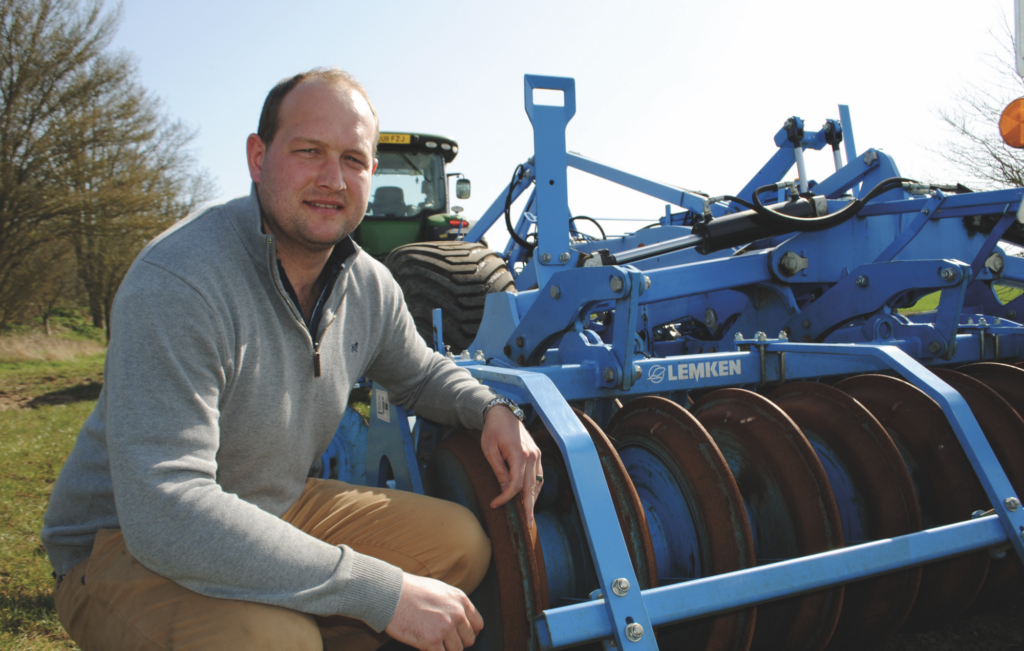Cultivation flexibility is the key to seedbed quality
17th September 2021
Flexibility is an important driver for Suffolk farmer Harry Middleditch, in implementing a rotation regime that maximises his options for producing a seedbed on difficult Hanslope soils. The tool of

Flexibility is an important driver for Suffolk farmer Harry Middleditch, in implementing a rotation regime that maximises his options for producing a seedbed on difficult Hanslope soils.
The tool of choice now is a 4m Karat 9, which gives Harry the confidence to practice minimum tillage techniques without compromising crop yields or soil quality.
D F Middleditch is a 340ha, heavy clay arable farm at Belchamp St Paul, which supports feed wheat and rye, a flock of 70 sheep and 40,000 free range broilers, as well as a wood chip biomass boiler. Poultry muck is used on the farm as fertiliser and to help reduce fixed costs, such as labour.
The plough-based tillage system has been replaced with minimum tillage cultivation tools.
Harry, who took over the running of the family business six years ago, aims to reduce input costs by 25 per cent over the next five years. Simplifying the cultivation regime has already made an impact on taking out input costs, by reducing the number of passes as well as burning less diesel and keeping spare parts replacement to a minimum. In the first year he has already reduced input costs by 10 per cent without compromising yields, which average 9.8t/ha.
Greater versatility and flexibility
There is potential in the future to go one step further and change to direct drilling. Replacing the plough required a cultivator which would offer maximum versatility and cost-effectiveness. The 4m Karat 9 is able to cultivate soil from 5–30cm and move the soil across the full working width of the machine.
The business previously operated two disc and tine cultivators from another manufacturer. One was replaced with the 4m Karat 9, which offers greater versatility and flexibility in the rotation, while the other has been retained for cover crops.
“Last year the Karat really came into its own,” he explains. “The wet weather exposed some deep compaction but by dropping the legs down to 22cm, we were able to lift it and help the water drain away.”
Harry calculates that seedbed preparation costs around £22.40/pass. Build quality of the Karat and minimal wear on the points means depreciation is very low too. It is now the main cultivator on the farm.
“The quality of the Karat is excellent. The original tungsten points have not needed changing, so by the end of this season they will have covered over 800ha. We might look to change them at the end of the year.”
But when the points do need changing, it is a very easy and fast process, he says.
“A quick release system means removing points is simple, so there is no need for hammers and spanners,” he says. “It should take about 20 minutes to change a full set of nine points and wings. We have a narrow and a wide set of points, which gives us greater flexibility and versatility to cope with most situations. Despite the Karat 9’s robustness and build quality, it is not a heavy machine.”
Light, quick machines
Reducing the weight of machines on the land is a top priority. “Compaction can be a problem on our heavier soils,” Harry explains. “It’s critical we are off the land if it turns wet. But, when it’s OK to travel we want to be using light machines and covering the ground quickly.”
The plan is to mount a Stocks applicator to the Karat 9 to drill cover crops in the spring as part of the Countryside Stewardship scheme.
“We plan to keep the Karat 9 for at least seven years because there’s nothing really on it that can go wrong. The rear packer has sealed bearings and there are no discs, so moving parts are not a problem.
“Improving our soils by minimal movement, and by reducing the need to cultivate at depth, should result in our seedbeds improving,” says Harry. “Each field is considered on its own merit according to rotation and what crop is being grown.
“I stereotyped the Karat as a light land cultivator, but it changed our mindset having seen it work. Of the three machines we tried, it was head and shoulders above the competition in terms of build quality, seedbed finish and levelling. Being able to move as much or as little soil as possible is so important to us. It gives us maximum flexibility. If you’re not measuring it, you’re not managing it, and so if it’s not essential to go deep then don’t.”
Satisfactory seedbed in one pass
By removing one of the packers on the Karat 9, Harry can produce a satisfactory seedbed in one pass, even in challenging soil and weather conditions. Being trailed rather than mounted, the Karat has proven an excellent tool for re- levelling fields.
A ram attached to the 3-point linkage of the machine helps to reduce draught and wheel slip on the tractor, which causes soil damage and compaction. It also helps cut diesel usage and therefore brings down establishment costs.
“We must look after our soils,” he says. “Rotation is key to maintaining soils and keeping them in good condition. Cover crops will improve soils and harness the sunlight while ensuring nutrient retention.”
The company currently has 56ha of cover crops, but the aim is to increase this to 80ha and, when all spring cropping is down to a cover crop, the total acreage will be 130ha.
Harry says the Karat will be integral to rotation planning going forward, because it will help eliminate the risk of poor seedbed management by being able to move the tilth when drilling in drier periods.


